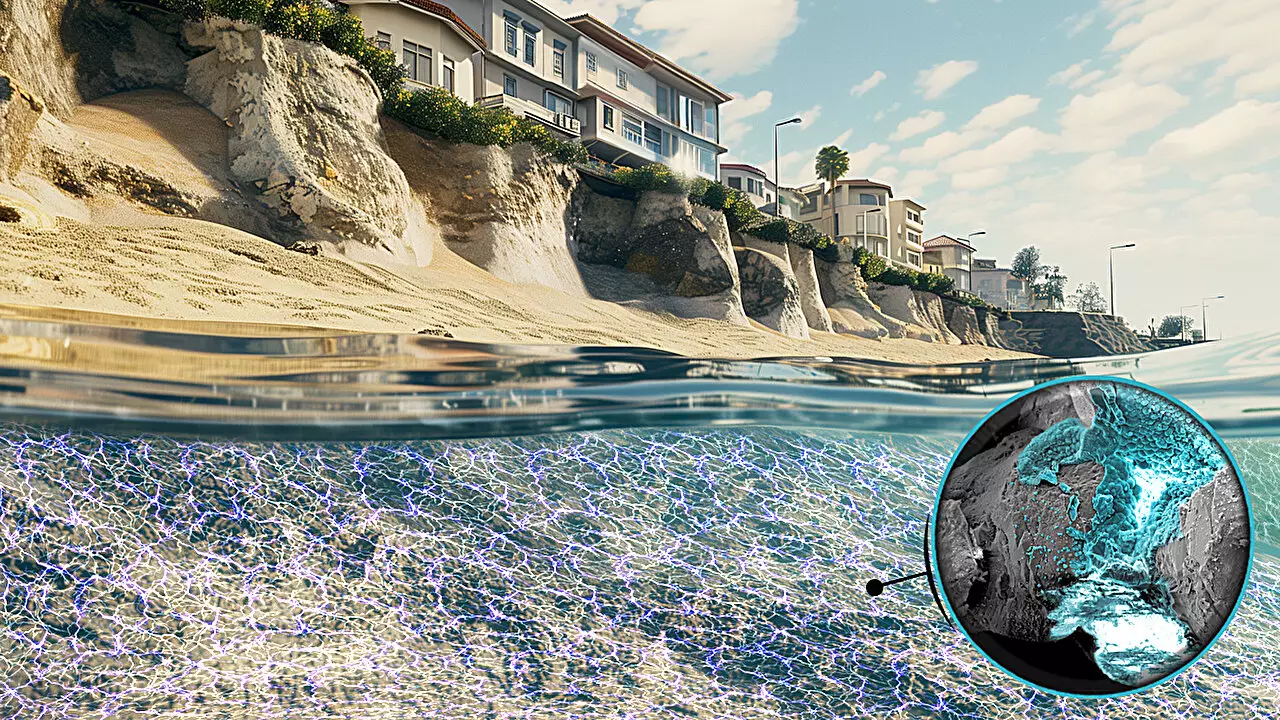Coastal erosion presents one of the most significant threats to habitats and human infrastructure worldwide. As climate change accelerates, rising sea levels and extreme weather conditions are supercharging erosion processes, endangering coastal ecosystems and communities. Billions of dollars are lost annually due to damage from coastal erosion, which affects over 40% of the global population living in these vulnerable regions. This pressing issue has led researchers to explore innovative, sustainable solutions to counteract these destructive forces.
Recent investigations led by Northwestern University, specifically spearheaded by Alessandro Rotta Loria, have illuminated a groundbreaking method for fortifying marine coastlines. Drawing inspiration from natural marine life, such as mollusks and clams, this research employs mild electrical stimulation to harness minerals present in seawater. Unlike traditional methods that involve building protective structures or injecting cement, this novel approach proposes the use of electrical energy to accelerate mineral deposition, creating a form of natural cement that binds sand particles together.
In essence, this method channels electrical current through seawater, prompting chemical reactions that convert dissolved minerals into solid forms, similar to how mollusks utilize these minerals for shell formation. The research highlights how, with just a modest electrical input of 2 to 4 volts, the components of seawater can coalesce to form robust calcium carbonate and magnesium hydroxide minerals, which have superior binding properties compared to traditional concrete.
Traditional approaches to coastal erosion frequently entail high costs and environmental ramifications. Common strategies include erecting sea walls or injecting cements—which often come with both environmental concerns and significant long-term maintenance requirements. For instance, sea walls, while iconic in coastal defense, eventually succumb to erosion themselves, leading to another wave of issues, including infrastructure disintegration and costly repairs.
Moreover, injecting cement into marine substrates typically demands high-pressure applications and intricate energy systems, further complicating the situation. In contrast, Rotta Loria’s electrochemical technique represents a game-changing alternative. This method not only addresses the mechanical weaknesses of existing structures, but also offers a cost-effective solution at an estimated $3 to $6 per cubic meter of treated sediment compared to the existing $70 for traditional methods.
The laboratory trials yielded remarkable results, showcasing the transformative potential of applying a mild electrical current to sand. The resultant material displayed rock-like properties, demonstrating the ability to remain stable and cohesive without requiring additional treatments. These findings have implications beyond mere stabilization; they suggest the ability to heal existing cracked reinforced concrete structures, thereby extending the life and functionality of current coastal infrastructures.
The technique holds a promising future for broader applications, with potential uses for strengthening the seabed beneath protective structures, stabilizing coastal dunes, and securing unstable slopes. Rotta Loria emphasized the versatility of this approach, suggesting wide-ranging avenues for coastal protection and structural restoration.
Harm to marine ecosystems is a critical concern in any erosion mitigation strategy. However, preliminary studies have indicated that the voltages employed in this innovative approach are low enough to pose no threat to aquatic life. This feature sets it apart from many conventional methods that can compromise marine habitats while providing structural solutions. Future research seeks to expand these findings and ensure that environmental integrity remains intact.
Another significant aspect of this electrochemical process is its reversibility. If communities no longer wish to maintain solidified sand structures, the same electrical stimulation can be reversed. By switching the electrode charges, the minerals can be dissolved back into their ionic forms, returning the area effectively to its original state and providing communities with control over their coastal environments.
As climate change continues to evolve, so too must the strategies employed to protect our coastlines. Northwestern University’s innovative approach to erosion mitigation serves as an inspiring example of how we can harness scientific principles to create solutions that are sustainable, cost-effective, and minimally invasive to our ecosystems. With plans for further testing beyond laboratory conditions, this revolutionary method could change the landscape of coastal management, inviting renewed hope for communities at risk from the relentless forces of nature. In a world that is increasingly experiencing the effects of climate change, finding and implementing effective solutions is no longer a luxury—it is paramount.


Leave a Reply